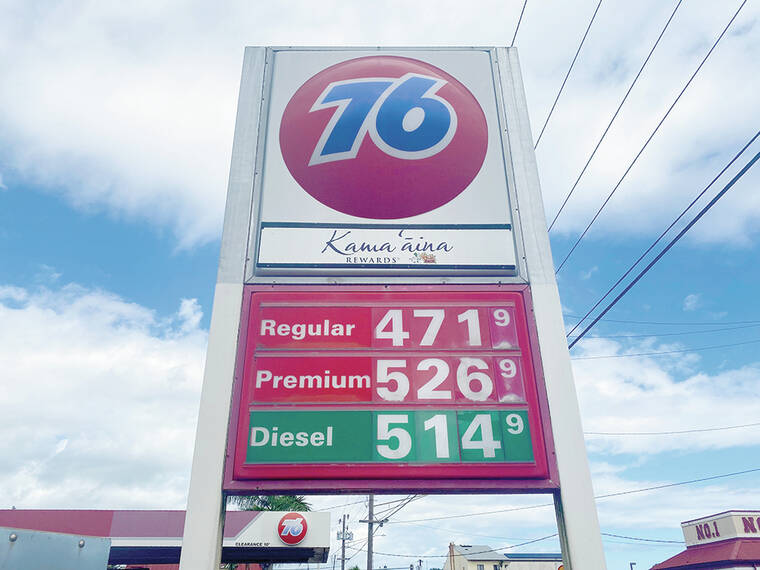LIHU‘E — “Milk has gone up, Portuguese sausage has gone up. Chicken has gone up for sure,” Tiffany Marrotte said as she loaded her car with groceries outside the Lihu‘e Costco Tuesday morning. “I didn’t get paid more this year and I still need to accommodate that.”
Rising prices in Kaua‘i stores reflect a nationwide trend seen in a new federal Bureau of Labor Statistics report which showed that food-at-home prices jumped nationwide by 7.4% from Jan. 2021 to Jan. 2022. That’s the biggest increase since the 2008 financial crisis.
While BLS data released last week shows that wages also increased by 4.7%, this doesn’t keep pace with the rising cost of living.
The report shows large price spikes for beef (16%), chicken (10.3%), eggs (13.1%) and coffee (8.6%), among other commodities.
“You don’t want to raise the price too much because people get accustomed to paying what they pay,” said Scott Hailer, a chef at Kaua‘i Beer Company. “We used to do prime rib, but now it’s out of the question.”
Hailer reported that the price of prime rib at wholesale retailer Costco had ballooned from less than $9 to nearly $15 a pound. Pork butt used to be 99 cents, he said, but now it was around $2.50.
“It’s made us switch our menu around to what we could find that’s affordable,” he said.
Meanwhile, gas prices have ballooned 40.8%, used-vehicle prices have increased 40.5% and tools, hardware, equipment and supplies have increased 10.7%.
Resident Jared England hadn’t noticed a dramatic increase in food prices, though in working on his home this year he saw that building supplies had shot up in price. “Those materials have gotten exponentially more expensive,” he said.
Food increases are more extreme in Hawai‘i than on the mainland, with food-at-home costs increasing 9.9%, and the price of meats, poultry, fish and eggs jumping 22% in Hawai‘i this year.
Though many statistics don’t exist for specific food prices on Kaua‘i, comparing Longs Drugs coupon catalogs through the years can give a sense of how much certain products have increased.
A 15-pound bag of Diamond G Calrose Rice that cost $9.79 in Nov. 2020 was $11.99 last week. A pack of May’s Hawai‘i Beef Patties that sold for $8.99 in Nov. 2019 now costs $9.99; a 24-pack of Aquafina water that cost $5.89 now sells for $9.59; Yuban ground coffee that was two for $10 now sells for $6.99.
Meanwhile, the price of gas has exploded here, from an average of $3.67 per gallon for regular a year ago to $4.72 a gallon last week, according to AAA’s gas price calculator, making for a 28.61% difference.
Why is this happening?
There are many factors at play in the rising costs of many things, and among the most significant is the lingering effect of the COVID-19 pandemic on the supply chain.
“Most of this is still very much related to the pandemic and supply shortages,” said Dr. Carl Bonham, director of the University of Hawai‘i Economic Research Organization.
“There have been supply bottlenecks and shortages in the food-manufacturing process,” said Bonham. He cited meat-packing-plant closures and slowdowns as a possible cause of increased meat prices, and chip shortages as a driver of increased car prices. “Also, we’re still dealing with omicron and the effect that that’s having on the labor market.”
Another major factor is the price of energy sources — like gas up 40.8% nationwide and fuel oil up 46.5%.
“Energy touches everything,” said Bonham. “It’s definitely flowing into rising food costs.”
The increased cost of energy sources like oil and gas contributes to increased shipping costs, which can then be passed down to the consumer.
Hawai‘i is particularly affected by oil-price increases because the state relies on oil for more than 60% of its electricity, according to the U.S. Energy Information Administration.
Yet Bonham pointed out that the overall rate of inflation in Hawai‘i is actually not as bad as it is nationwide — 6% compared to 7.5%.
He said that much of the reason for this disparity was a lower rate of inflation for shelter, 2.9% compared to 4.5% nationally.
Unfortunately, this means that things might get worse before they get better.
“Over any extended period of time, our inflation rates are going to be very similar to the U.S. We will catch up, maybe not to 7.5%, but we’ll follow the same basic pattern,” he said.
“We’re anticipating that inflation will actually go up this year. It’s mostly because of the persistence of the energy component and the fact that we haven’t seen higher inflation numbers in housing yet. Usually, the cost of rent hits with about a one-year lag.”
Bonham didn’t expect the rate of inflation to begin decreasing until the end of this year, after which he predicts it will continue declining until it reaches a sustainable level of 2% in 2024.
•••
Guthrie Scrimgeour, reporter, can be reached at 647-0329 or gscrimgeour@thegardenisland.com.






This inflation and supply chain shortages are not due to the pandemic, covid began 2yrs ago and we never experienced anything like this, it’s Joe Biden and his multiple massive spending bills, cutting pipeline, spending our tax dollars on letting in millions of illegals and transporting them all over the country. He is the reason for all of these problems.
Thanks Joe! Hey, I know, let’s pass build back better and pump even more money that we don’t have into the economy, that will bring inflation down!
You can thank the current administration, and everyone who voted for them, for the wonderful gift they have given the American people in terms of inflation and making any pay increase you did receive nullified. They are still trying to sell us on more lies, and they see nothing wrong with that. Way to go…..!!!